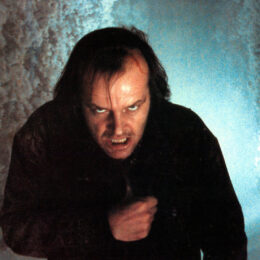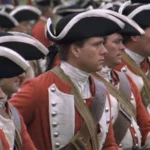The Shining. The ultimate horror explained
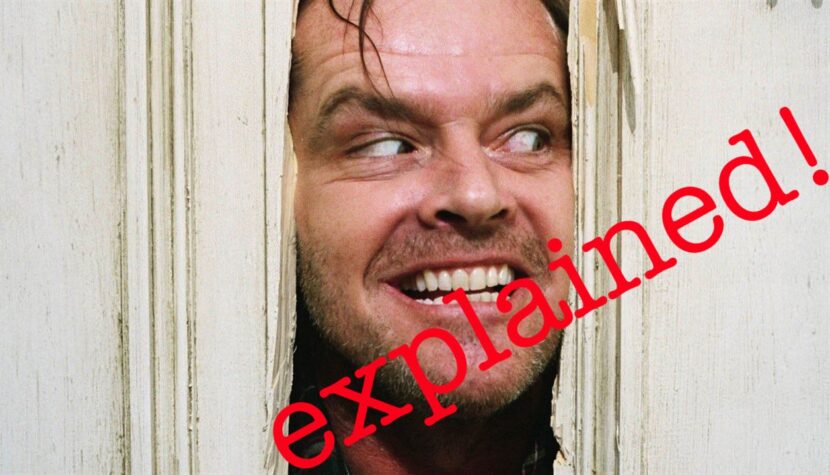
Trailer
The hall, the door, empty, quiet … suddenly, slowly, blood begins to pour from both sides of the corridor … hectoliters of blood. The camera stands still and watches as the red wave slowly and consistently approaches, splashing against the walls and objects encountered on the way. Finally, the bloody flood reaches the camera, floods the entire screen, and only then is the inscription shown, which will go down in the history of cinema forever, and which reads: The Shining. This is what the amazing trailer looked like in its entirety, advertising Kubrick’s 1980 film. The sequence took an entire year to complete because Kubrick, known for his maniacal perfectionism, insisted that the red substance brought to the set was still too far from real blood.
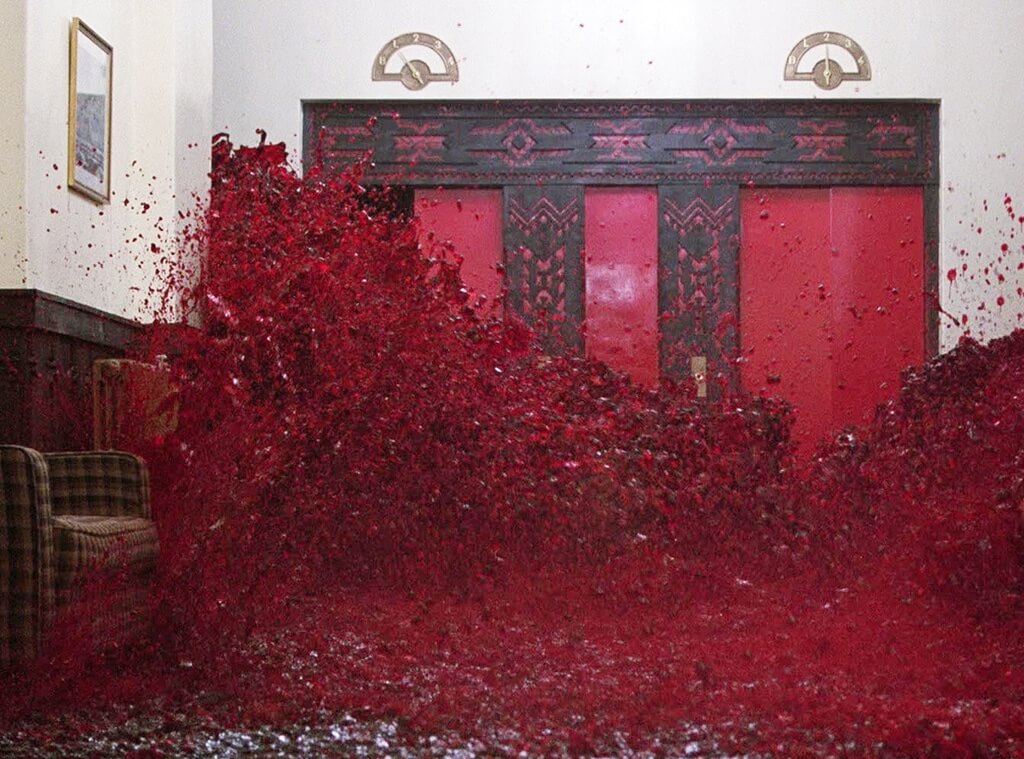
Related:
Opening credits
The opening credits of The Shining are an example of the extraordinary simplicity of form and, paradoxically, a genius in building the atmosphere already at the stage of the opening credits. Stanley Kubrick forged miles of film to shoot picturesque locations from a helicopter, illustrating this mesmerizing, unforgettable opening credits (some unused shots ended up in the end credits of the excellent Blade Runner a few years later). The film begins, the camera glides over the water, flies over the islet and trees… and all this to the accompaniment of climatic music, which after a while changes face like the luminous angels from the Ark of the Covenant, suddenly turning into demons of death – in Raiders of the Lost Ark. The camera moves on, over mountains and forests, and finally a car appears; it’s Jack driving his Volkswagen to sign a deal with the owners of the Overlook Hotel. He doesn’t know that he is about to sign documents that will change the fate of the Torrance family and the history of horror movies – forever…
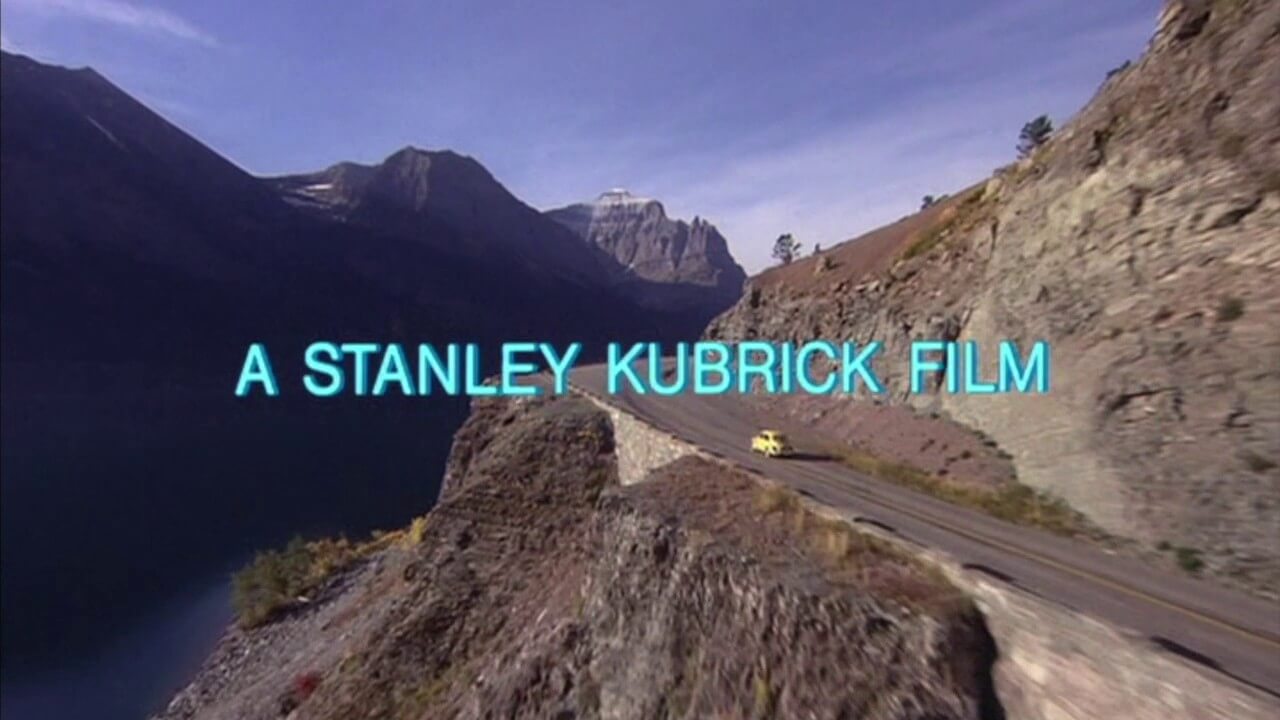
The movie decoded
The Shining is a film that can be viewed on several levels; religious, if we assume that the evil born in Jack is the temptation through hell in the form of ghosts of people who died various deaths during the many years of the history of the Overlook hotel. This version is supported by the fact that the hotel was built on an Indian cemetery, and that everyone: Jack, Wendy and Danny experienced a meeting with ghosts. Psychological, assuming that Jack suffered from an ordinary split personality – it is easy to see that whenever he meets somebody whether the woman in the bathtub, or the bartender Lloyd, or finally Delbert Grady (waiter who flooded Jack with liqueur), he looks in the mirror; the mirror in room 237 – when he notices that the girl he is embracing is actually the decomposing body of an old woman, the mirror behind the bar – to which Jack starts talking before Lloyd appears in front of his eyes (as if on cue), or, finally, a mirror in the bathroom – which is located behind Delbert Grady’s back – so if Delbert wasn’t there, Jack was talking… directly to the mirror.
Only in the scene in the pantry there is no mirror, which does not contradict the theory of Jack’s schizophrenia, because he ‘talks’ to Grady through the closed door, and Grady is never shown. An interesting fact is that the Grady that Jack meets at the July 4th Ball in 1921 is named Delbert, and the Grady who was the keeper of the hotel in 1970 will be named Charles – this name difference shows that Grady just like Jack was at the Overlook Hotel… twice, once as an employee (young Jack in the photo that closes The Shining is standing among the participants of the AD 1921 ball!!!), the second time as a guardian committing a crime on spouse and child/children.
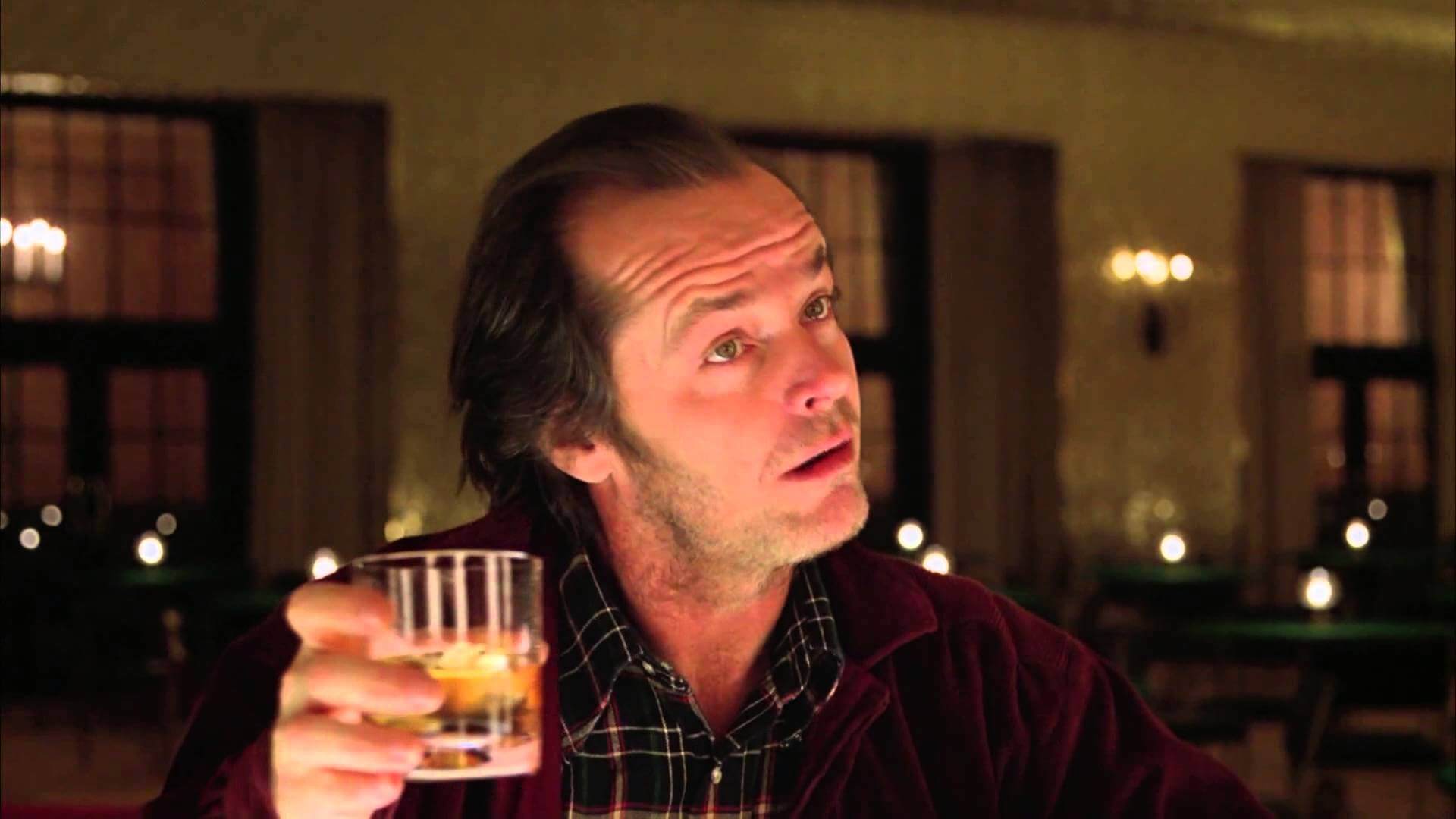
But back to the theory of schizophrenia (because we have strayed far from the topic for a moment); if this theory is true, there were no ghosts in the Overlook Hotel (which contradicts the religious version), and Jack, due to isolation and being constantly in the company of his annoying, grumpy wife (with permanent exophthalmos) and sickly son, suffered a schizophrenia and began to talk to himself, and thus; give orders and commands to oneself (this includes self-justification for one’s criminal tendencies), as well as reprimands for ‘handling the wife and kid wrong’. The theory of schizophrenia is perfectly complemented by the shot when Jack, going to the “Cold room” ballroom for the first time, draws words through his teeth, talking to himself – the first signs of a split personality.
Unfortunately, as with any bold theory, there is a loophole in this one as well. If the ghosts in the Overlook Hotel didn’t exist, who then opened the door to the pantry where Wendy had locked Jack? If you are stubborn, you can assume that this door was equipped with a safety handle, which, when pressed from the inside (after all, Jack, while begging Wendy to open the door, rests his left hand firmly on something like a handle – but does not turn it) opened the door. But let’s leave the issue of Jack’s schizophrenia on hold for now and move on to the third, final plane of the film. And the last plane (we will move on to King’s book original in a moment, because this is a completely different topic) is simple, human imperfections that contributed to the tragedy that played out in the Torrance family.
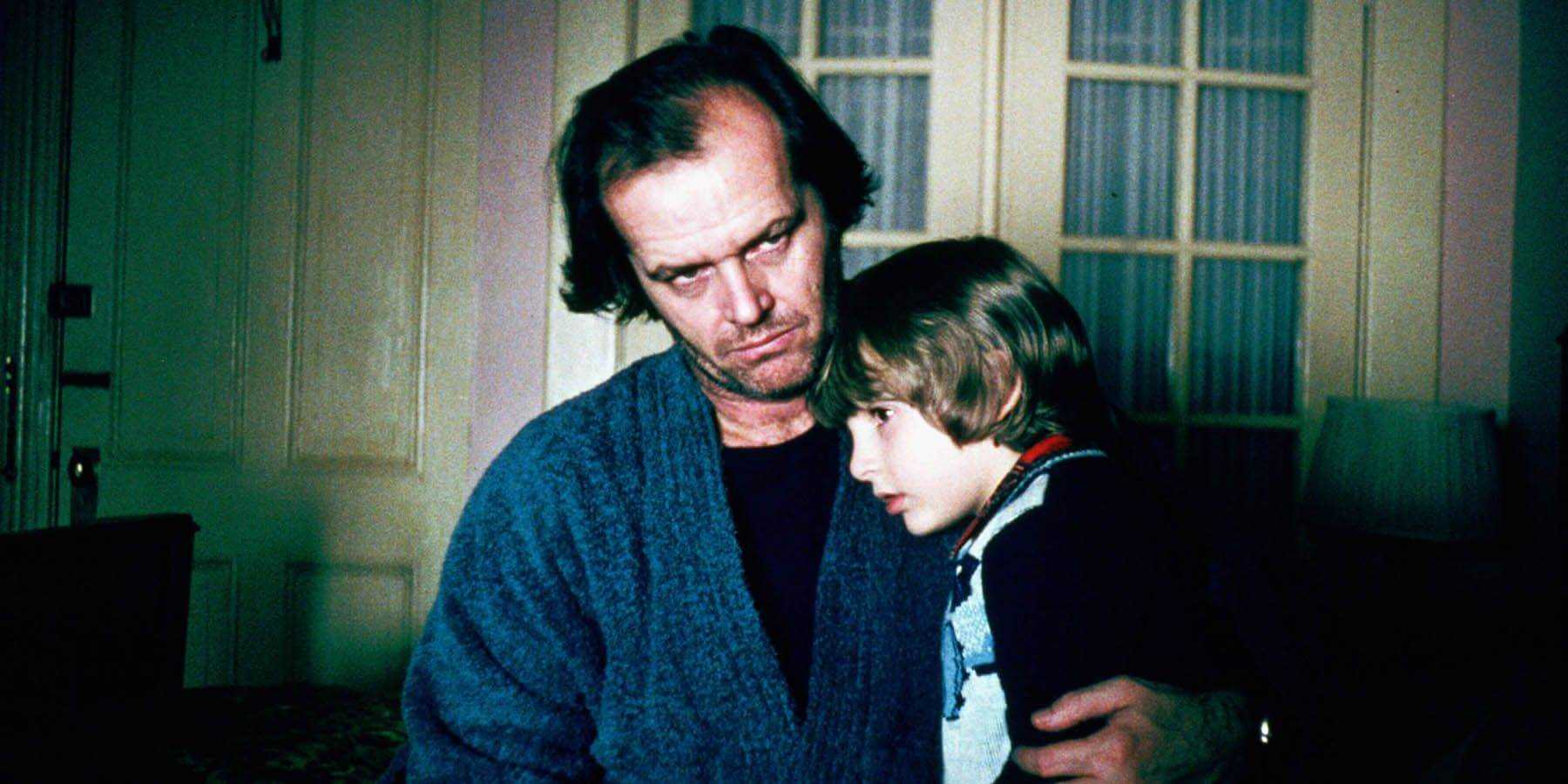
Jack, unable to admit to his family and himself to a simple lack of writing talent (after all, nothing is said in the film about any of Jack’s writing successes so far), gradually falls into madness. He keeps telling his wife that it’s all because of her (“You fucked up my whole life”) and he treats his attempts at writing absolutely seriously, although the only thing he managed to write during a few months of his stay in Overlook were hundreds of pages containing one sentence: All work and no play makes Jack a dull boy (Kubrick made several versions of Jack’s gibberish work, depending on the country showing the film, for example in Italy viewers could read the written saying Who gets up in the morning, God gives to him several hundred times, in Germany : Don’t put off until tomorrow what you can do today, and the Spaniards something like: Don’t praise the day before sunset. Jack can’t accept the fact that the only thing he can really do is clear snow from driveways or work in a car wash (Stephen King himself used to do these jobs), or what he is currently trying to do, i.e. guarding / overseeing the hotel. He blames everything and everyone but himself for his writing failures.
Adding to this the growing sense of isolation, the nerve-wracking company of his wife and son and the alcohol he had drunk (although if you assume the schizophrenic version, there was no alcohol at all) created an explosive mixture and Jack had no choice but to grab the axe and smash everyone and himself because All work and no play makes Jack a dull boy.
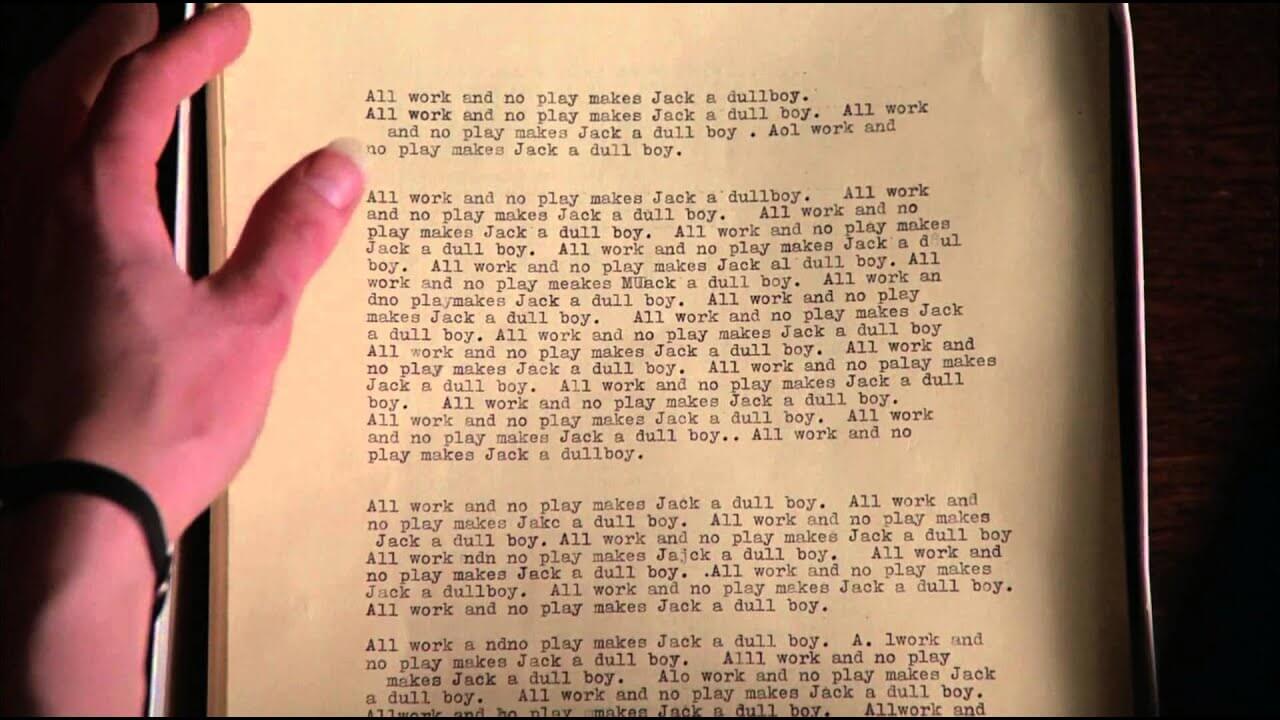
Axe scene
While the vast majority of the film was built with slow, carefully thought-out shots (so thoughtful and so perfect that Shelley Duvall repeated one shot a meager 127 times, and Scatman Crothers – who also starred with Nicholson in One Flew Over the Cuckoo’s Nest – repeated a shot of The Shining in his bedroom 120 times, and Kubrick wanted to shoot Halloran’s death scene 70 times, which Nicholson talked him out of, explaining that the then 70-year-old Scatman Crothers should not play the scene more than 40 times (!). The action developed extremely slowly, so the moment when Jack starts breaking down the door with an axe is the absolute opposite of everything the director has shown us so far, as if he was preparing for a sudden, final a jump and a quick, unexpected attack, because suddenly, the lethargic, lazy (though strangely very suggestive) and dense atmosphere of the seemingly empty Overlook hotel is cut by the blade of an axe. And it cuts in a completely unconventional way!
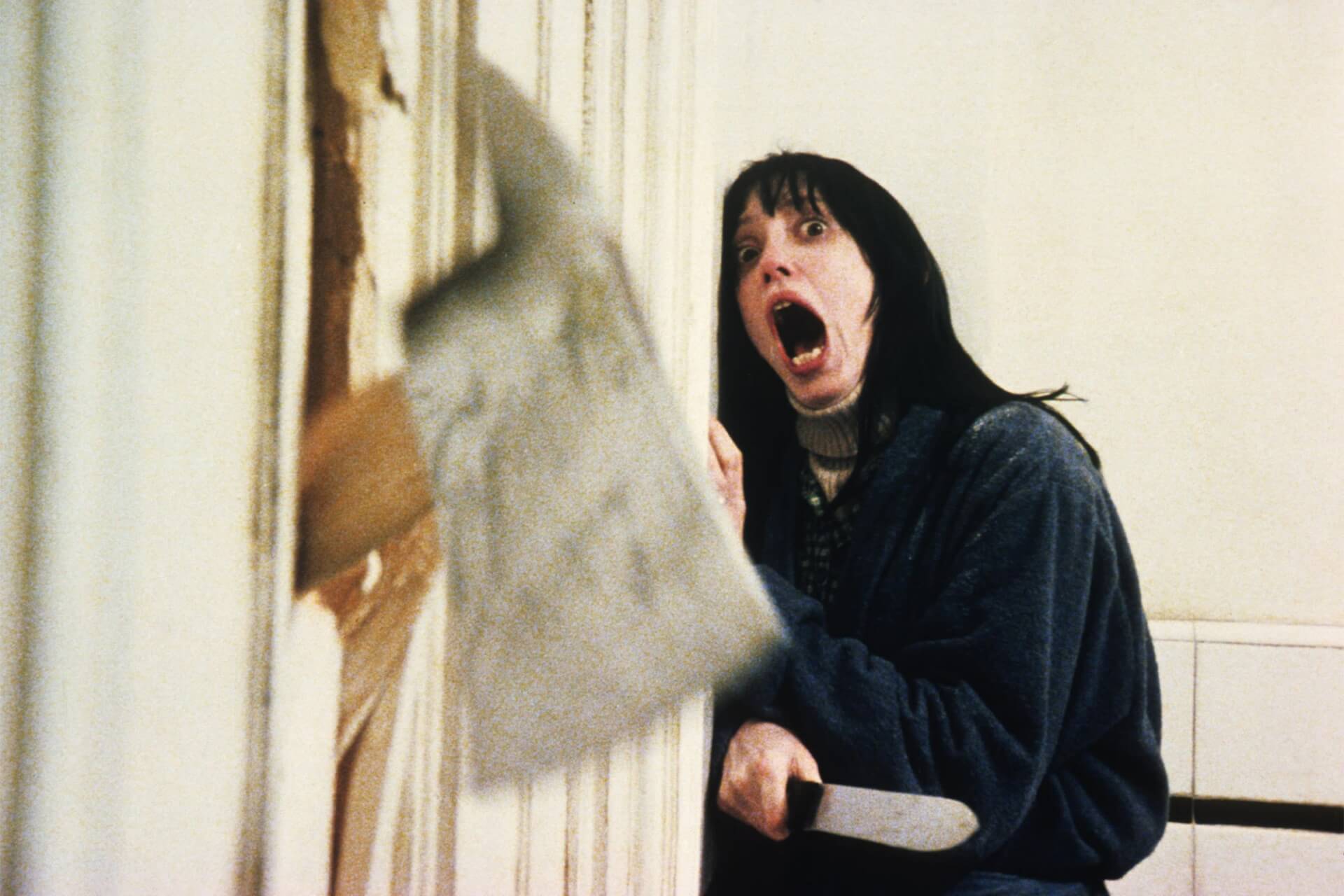
So far not very dynamic, the camera suddenly comes to life and follows Jack’s arm, following him with the precision of a surgeon as he strikes and swings, swings and strikes – the camera’s eye moves from left to right of the screen, causing a devastating feeling as if we were watching shocking Jack’s attack on the door of the room where Wendy and Danny are standing right next to him. What’s more, Kubrick, not afraid of seemingly boring repetitions, has his camera follow not one or two axe strikes but as many as 6 (the rest of the 17 strikes are only audible), until he cuts a hole in the door suitable for sticking his hand there and turn the key. In modern times, such a scene would probably be filmed with the help of extremely dynamic 20 shots and 40 quick edit cuts.
But not with Kubrick. After all, The Shining is full of non-standard solutions; a Steadicam following Danny as he races through the halls in his trike (the operator was in a wheelchair pushed by crew members so that Danny could be filmed as he rallies around the hotel corridors), and a shot of Jack trying to beg Wendy to open the pantry door (according to the documentary, Kubrick himself was lying on the floor next to the camera operator – under Jack Nicholson, personally helping to create this unforgettable shot!).
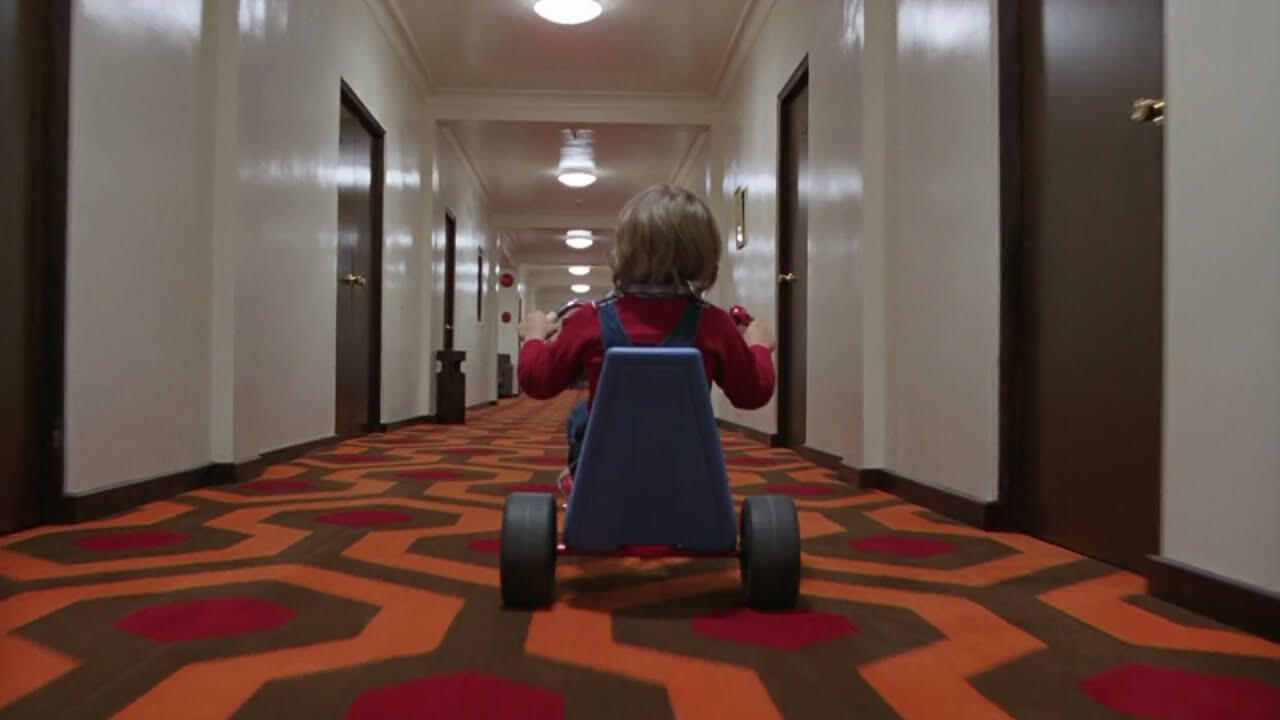
Returning to the ‘axe sequence’, after breaking down the first door, a series of Jacek’s monologues follows, which immediately find their place among the classics film quotes. After walking through the door, Jack ‘cheerfully’ calls out from the doorway, “Wendy, I’m Home!” (an explicit reference to the Hannah Barbera cartoon The Flintstones). And when Jack walks to the bathroom door (behind which Wendy is) and before he can cut his way out, he puts on a ‘bad wolf’ face saying: “Pigs, pigs, let me in… We won’t let you in! and I will blow your house down!” (Jack Nicholson took this line from a Warner cartoon) and then again 12 more axe blows! Kubrick really wasn’t afraid of repeating the same visual solution, because he knew how powerful this seemingly trivial shot was.
After a while, when Jack sticks his head into the bathroom through the previously cut hole, he fires at Wendy with the text: “Here’s Johnny!!!” (Nicholson borrowed the phrase from John Carlson, who launched his 1962 TV show The Tonight Show Starring Johnny Carson this way). The Shining is now legendary, cult, and classic partly thanks to those final lines delivered by Jack and, of course, thanks to the great performance of Jack Nicholson. It’s best seen during conversations with Lloyd – brilliantly shown nascent madness (that demonic laugh) painted on Nicholson’s devilish face, the words spoken with unusual calmness: “Wendy, I don’t want to hurt you… I just want to smash your head” and, ultimately, facial expressions, in the immortal scene “Here’s Johnny!”. Unfortunately, the Film Academy did not notice Nicholson’s excellent acting, just like a few years later, one of the most famous SF films Blade Runner and the phenomenal role of Rutger Hauer will pass unnoticed through the Oscar mill.
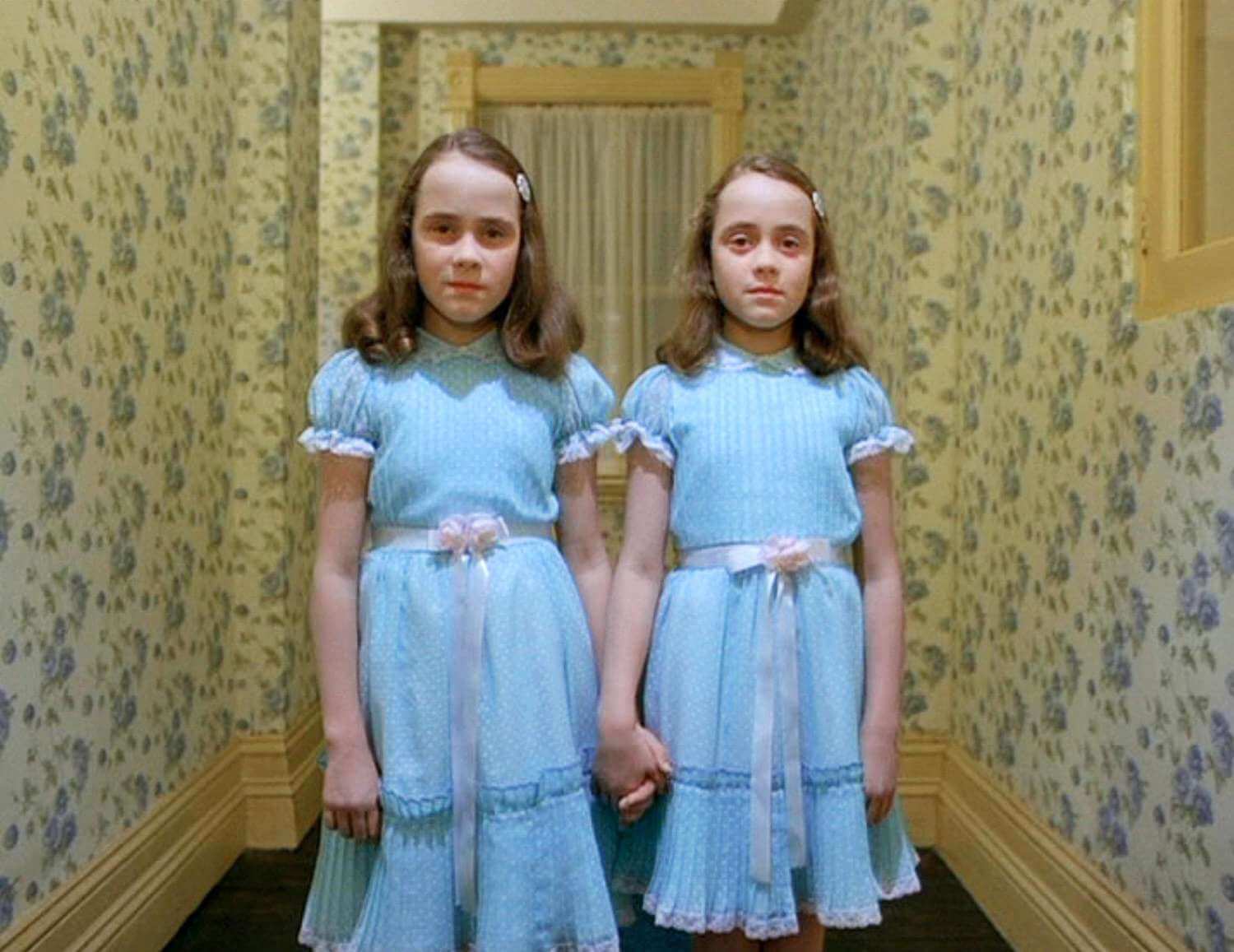
What’s more, Stanley Kubrick himself was nominated for the Razzie award for the worst director, and Shelley Duvall for the worst female role (which is easier to agree with).
On the other hand, the role of Shelley Duvall, ridiculed and criticized for exaggeration, could have been a deliberate move by the director, who consciously cast an actress in the role of Wendy and gave her such irritating features that the viewer even cheered for Jack to finally catch this annoying, hysterical, whining woman and close her mouth once and for all. Danny Lloyd remains an absolute curiosity of the cast (Jack Nicholson and Danny Lloyd played characters with the same names as their own), who, having only 7 years old, at the time of filming didn’t even know he was in a horror movie – Kubrick had to think hard to get Danny to play the horror right, even though there was nothing scary in front of his eyes on the set. He only found out about it after the premiere, and The Shining remains to this day his first and last appearance in front of the camera.
The monologue: “Redrum, redrum, redrum…” (I wonder if Danny’s screeching, spine-chilling voice in this scene actually belonged to him?) and the stoic calm is one of the most recognizable movie quotes of all time. Currently, Danny Lloyd is a teacher in Illinois, USA and is not associated with the world of film in any way.
Why did King hate Kubrick?
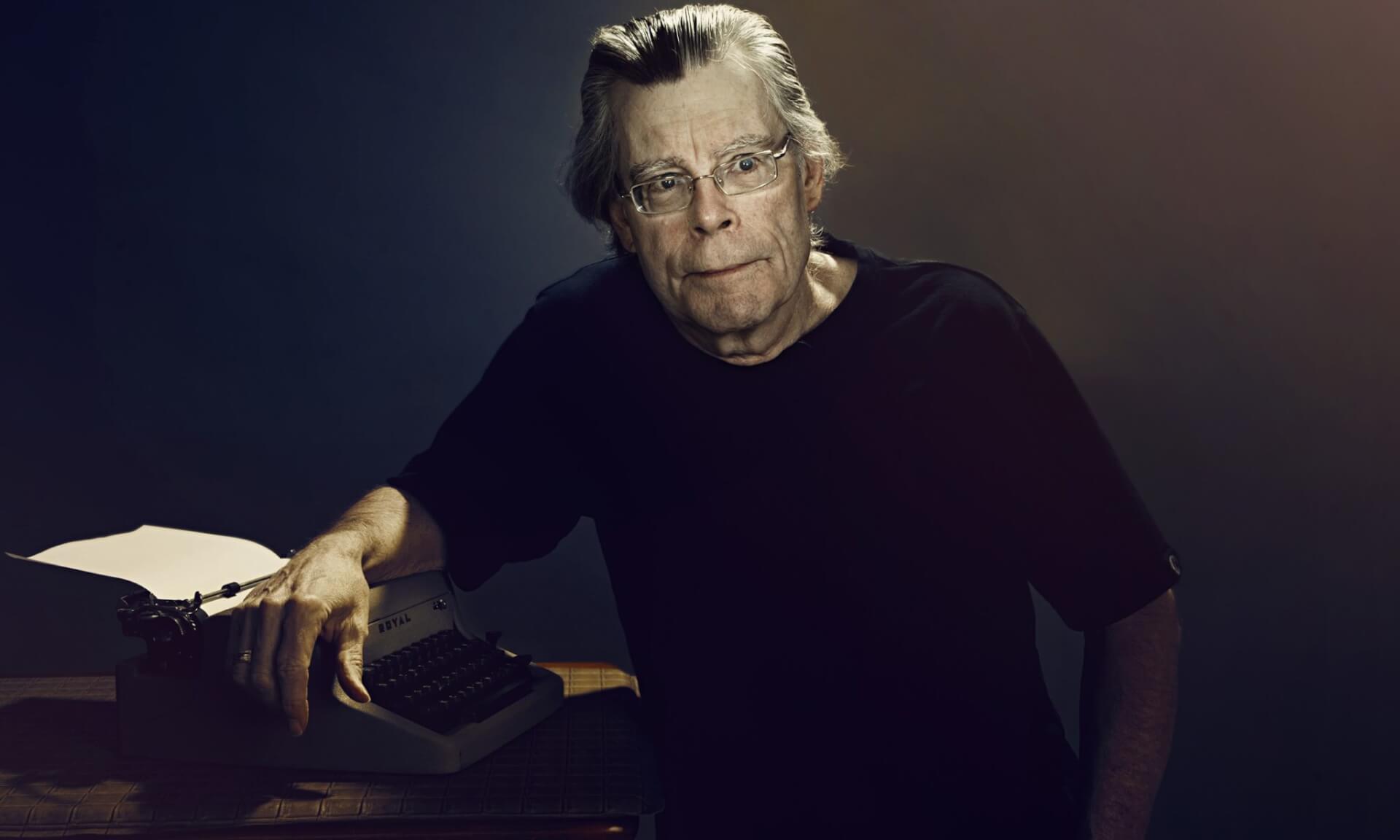
Stephen King is a master of literary horror, Kubrick of film art – The Shining was the director’s first attempt at the horror genre. Here comes the ‘cooperation’ of two giants. Stanley Kubrick stripped the book of many important, though unnecessary elements. Kubrick mostly passed on the the theme of Jack’s alcoholism (extensively developed in the book) and many memories from the past. He left only the main characters and the theme of the empty hotel. You might say he hewed King’s book as you can hew a wooden beam, giving it a shape of a sharp spear. Of course, this is not a vote against King’s book – I am far from it – simply what worked perfectly in the book could not be included in the film, and since Stanley Kubrick had an extraordinary personality, he did not want to make a film adaptation, but rather a variation, on the theme of The Shining.
So when Stephen King watched Kubrick’s movie, he felt offended by the director and said that Kubrick did not understand his book and did not understand the assumptions of the horror genre at all. Yes, in some respects I have to agree with King. For him, The Shining was an extremely personal story in which he included many threads from his own life, although only years later he admitted that during the period when The Shining was being created, he himself – like Jack in the book – was addicted to alcohol. So when King saw that Kubrick only hinted at Jack’s alcohol problems in a single sentence (the director’s cut of The Shining only released in the US expands this thread a bit!) – he had enough. It could also be controversial for the average viewer when suddenly Wendy sees a guy in a bear suit and behind him, another guy who has probably just received oral sex from his friend in disguise. The book thoroughly explains the genesis of this scene; there was a big masquerade ball in the hotel, after which there were various types of situations, including sex in various configurations. Kubrick skipped this part and that’s why a short scene with a man dressed as a bear suddenly interrupts the coherent plot of the perfectly buttoned-up film.
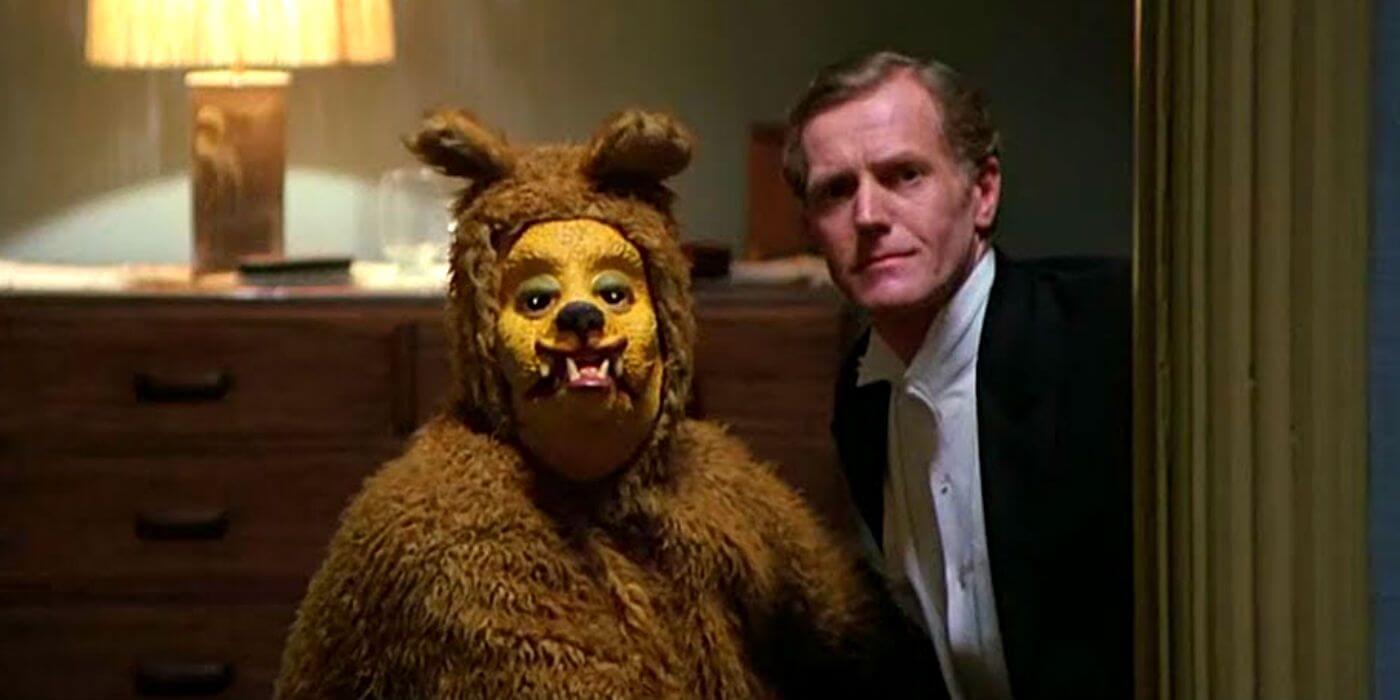
In addition, there were more significant changes and ‘corrections’, such as the replacement of ‘hedge animals’ that were supposed to come to life (Kubrick abandoned this for purely technical reasons!) for a gigantic, static hedge maze, which was supposed to both increase the feeling of isolation and confusion of the characters (scenes of Wendy and Danny wandering through the maze), as well as become a metaphor for the mental maze in which Jack himself is stuck (the scene in which Jack, leaning over the table, observes the mock-up of the maze). In the book Jack was running around the halls with a roque hammer, in the movie it was an axe. King’s hotel was an old building, with a furnace which, if improperly operated, could blow up under too much water pressure – Jack in the book dies in the great furnace explosion, due to his own negligence, for instead of looking after it, he preferred to run around with a roque hammer scaring his wife and a child.
However, Kubrick’s Overlook hotel is a thoroughly modern building, and the topic of the furnace is mentioned in the film only once, when Wendy presses some buttons on the device’s control panel. The film also lacks the motif of Jack finding old newspaper clippings in the hotel and many, many other subplots that are difficult to list here.

The last of the changes worth mentioning is the finale of the film, in which Dick Halloran dies (stabbed in the chest with an axe), and Jack freezes in a maze unable to find a way out – another metaphor. He was unable to control the madness growing inside him, he couldn’t get out of the labyrinth of his own mind. And the snow-covered hedge maze is just a physical reflection of it. In a book Jack dies as a result of the above-mentioned furnace explosion, and Wendy and Danny leave with a snow plow, together with … Halloran, whose life King spared.
So was King right when he accused Kubrick of not understanding the book? This is still an open issue and worth the discussion, so I will not pass judgments here, because everyone can have a different opinion, just as different opinion about The Shining had Stephen King and the ‘specialists’ awarding Razzie nominations. All I can say is that both the book and the movie are great works in their respective categories. Judging ‘what’s better’ is pointless here, because just as orthodox Tolkien fans chastise Peter Jackson for the adaptation of The Lord of the Rings, so dedicated readers of King, following the judgment of their master, can rebuke Kubrick’s The Shining for straying too far from the original.
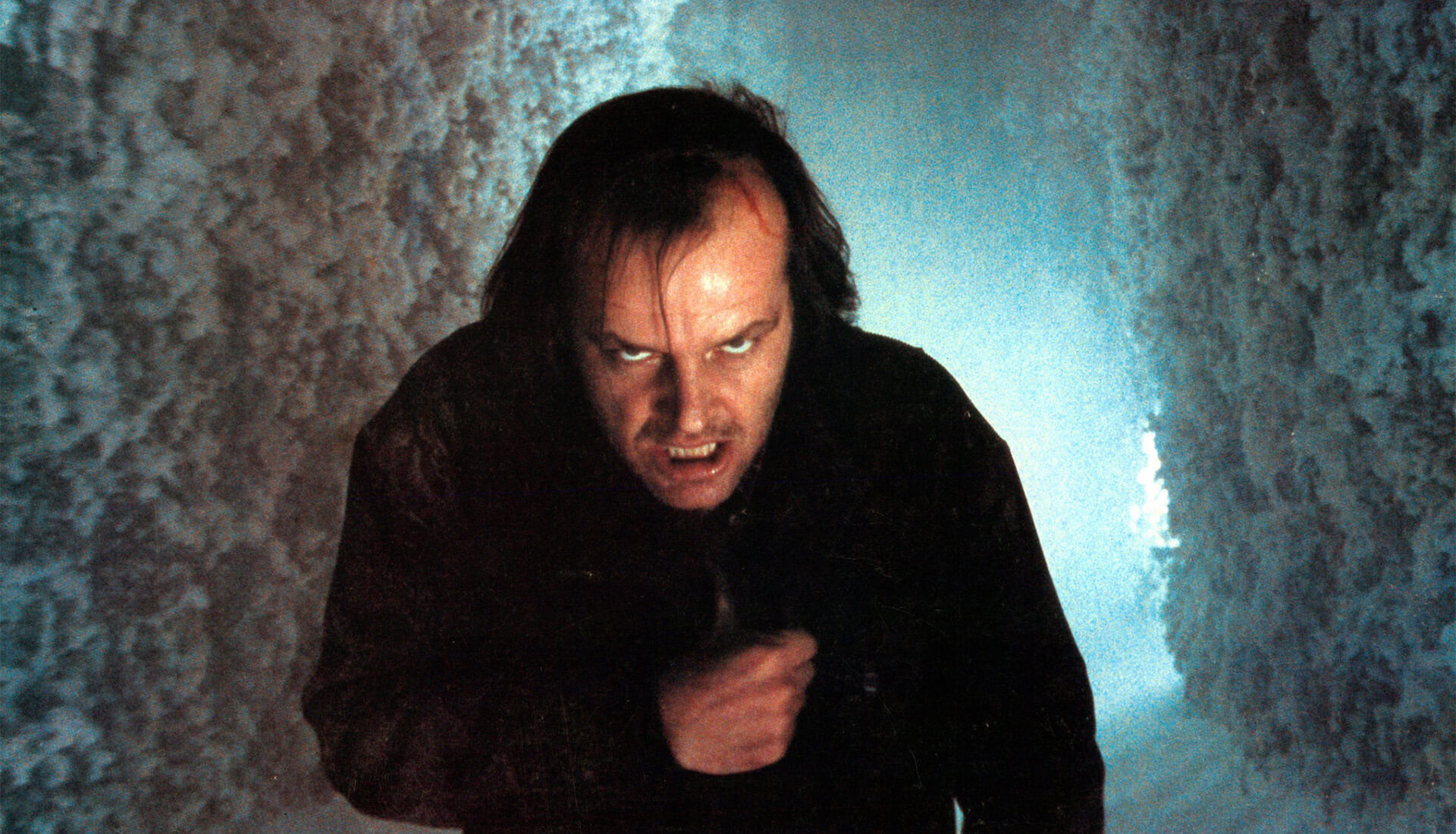
The book and the film speak a different language; where in the book multi-page descriptions of the state of mind work, one grimace must suffice in the film, where in the book 30 detailed flashbacks fit perfectly, in the film one sentence of explanation is sometimes enough. For all those who felt unsatisfied after Kubrick’s version and claimed that King’s book was mutilated, a 273-minute version was created in 1997 (TV mini-series, of which Stephen King himself was one of the executive producers), 100% compatible with the book original, which, despite the fact that it already contained scenes with hedge animals (computer animation), a fire hose coming to life and Jack chasing the family with a roque hammer … somehow failed to make an impression. As you can see, sometimes it’s worth tinkering with the master’s book (even at the risk of his wrath) and re-editing it a bit to create a masterpiece, which Kubrick, Nicholson, Duvall, Lloyd and the entire technical team, including Steadicam’s Garrett Brown at the helm, did.
The Shining by Kubrick, or the new type of horror
Only one person dies in the film – Dick Halloran. Despite this, The Shining remains to this day a thoroughly terrifying film that leaves the viewer with a sense of being surrounded by evil of unknown origin. While watching The Shining, we realize that Kubrick has made a horror film, really disregarding all the rules and principles of horror (he didn’t even follow Randy’s ironclad rules of horror from Wes Craven’s 1996 Scream). There are no creaking doors or half-burnt bulbs emitting intermittent light in The Shining. No, Kubrick sets the action in a modern building, without leaks, power failures and broken windows or perforated doors (pun intended). This, paradoxically, intensifies the impression that a haunted house does not have to look like a ‘scary mansion’, because evil can nestle anywhere, after all, it resides not in buildings, but in man himself.
In Kubrick’s we will not find shoddy formal tricks; a monster suddenly jumping out from around the corner with a simultaneous strong hit of the music. In Kubrick’s, the music attacks with full force in seemingly ordinary moments, although a shrill, unpleasantly creaking tone of horror accompanies Jack’s entry into Wendy’s room, as well as the second appearance of the famous twins – this time lying in a pool of blood.
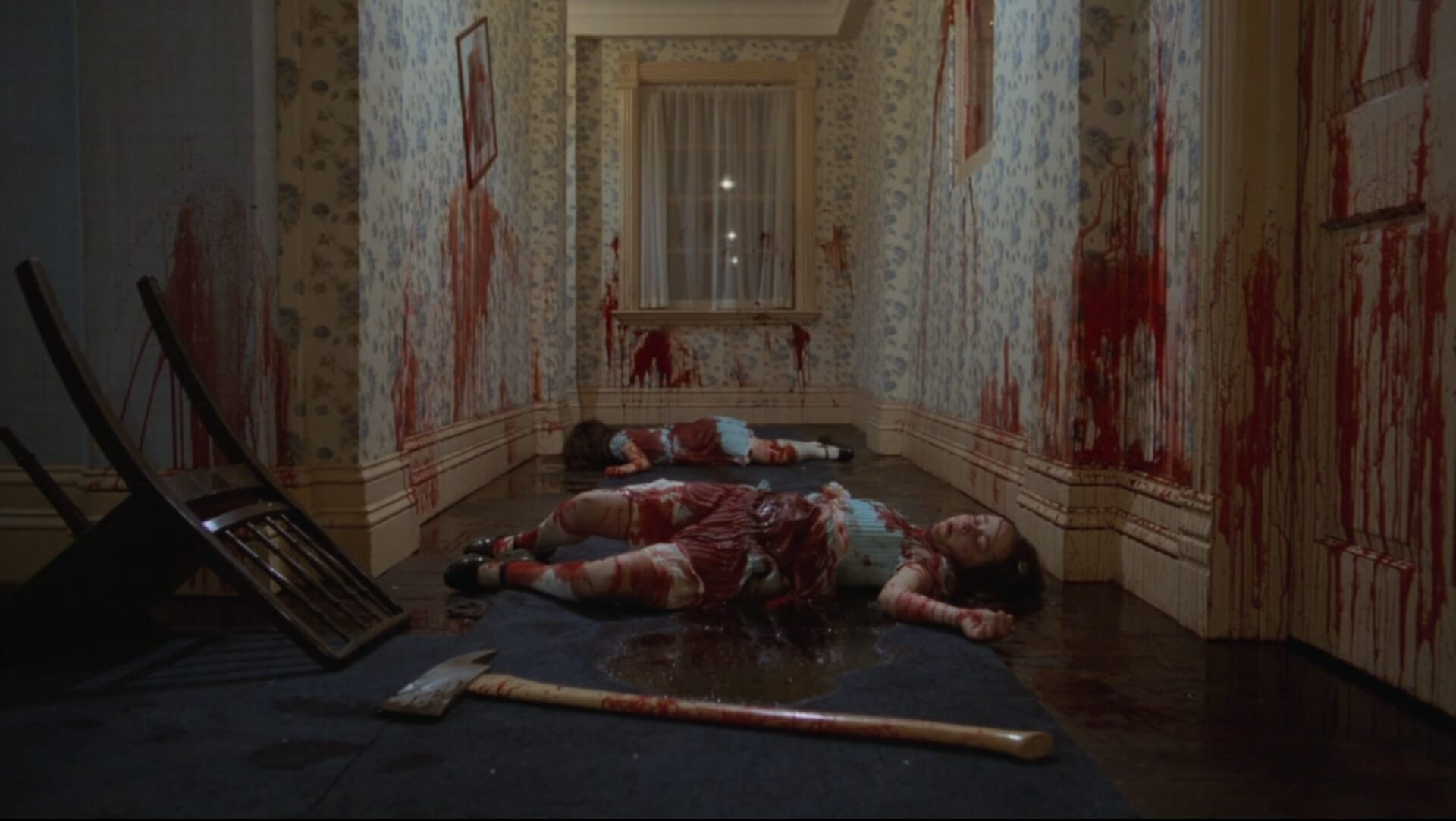
There is also no shadow play or any spooky stalking. What’s more, in the horror ‘by Kubrick’ there is practically no darkness at all, so characteristic for horror, and even inseparable for films of this genre. I’m not counting the night during the final scenes, because it doesn’t serve to create a mood of horror. Most of the nightmare that the Torrance family goes through anyway takes place in the bright interior of the hotel, and only Jack’s pursuit of Danny through the hedge maze is set in in circumstances close to darkness, although these are also brightened by the lighting placed in the labyrinth. Here, everything takes place in illuminated locations, where it seems to be completely safe.
So where is the horror in Kubrick’s The Shining? Well, right here, in the middle of the room where Jack is typing and telling his wife to ‘fuck off’. In the middle of the living room, where a trembling Wendy waving a bat whimpers that Danny needs to be taken to the doctor, and Jack repeats her words like a stubborn, cold, emotionless echo. It is in seemingly normal situations and conversations that Kubrick puts the greatest dose of emotion and psychedelia. He is additionally enhancing the effect with the music. Apart from the compositions of Wendy Carlos and Rachel Elkind – yes, two women composers, you can hear compositions by Bela Bartok, Gyorgy Ligeti and Krzysztof Penderecki, which basically devoid of melody attack the viewer’s ears with a ghostly sound, making a simple dialogue scene a masterpiece of horror. In addition, the interior of the Overlook hotel was built from scratch in the production hall (some of the sets from The Shining, after being reassembled, served perfectly on the set of Raiders of the Lost Ark), thanks to which cinematographer John Alcott and Steadicam operator Garrett Brown could film everything beautifully lit with natural light.
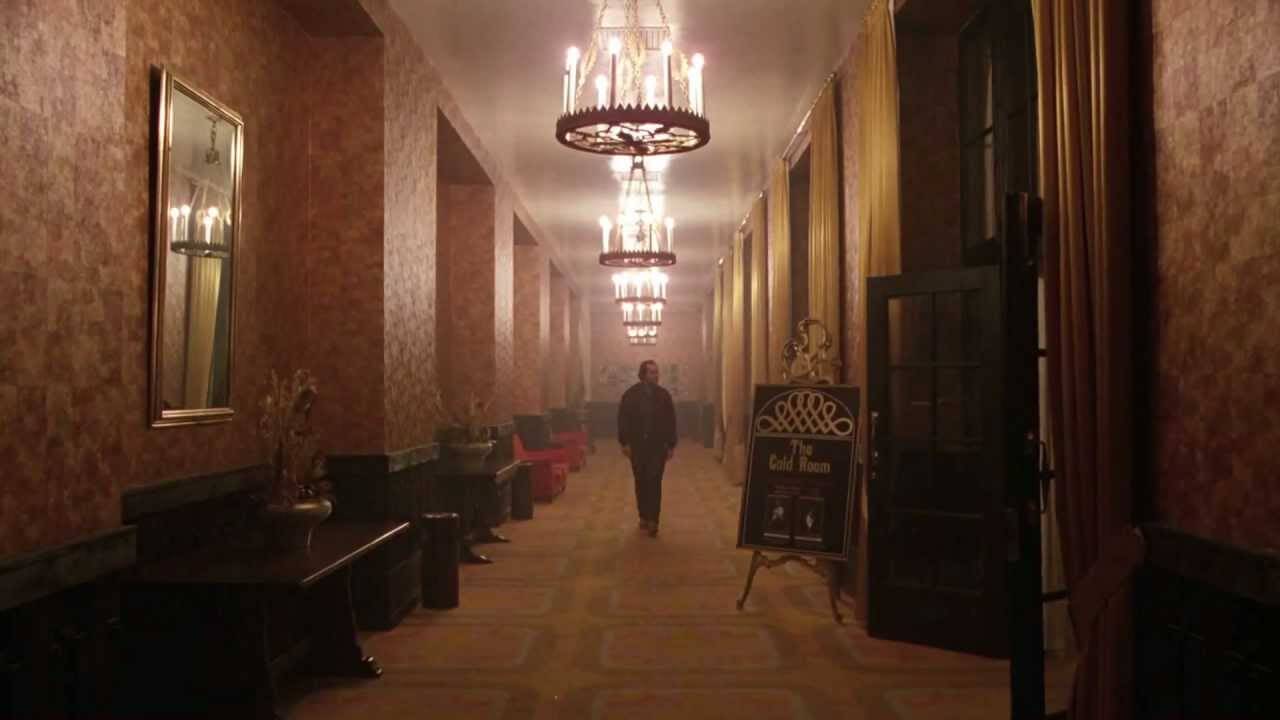
The ceiling, a phenomenon rarely seen in films, additionally enhanced the impression of the characters being completely enclosed within four walls. Therefore, the 4:3 aspect ratio was ideal for this film (Kubrick consistently avoided making films in other formats). And working with the Steadicam enabled the free presentation of what is in front of the characters, behind them, above their heads or right next to them. The Shining is probably the first film in the history of cinema, which was shot almost entirely with this invention (the Steadicam was also used by Kubrick in Eyes Wide Shut, a film which, similarly to The Shining, is edited with the use of a diffusion effect in several moments). It all adds to the mood of horror, because we see the entire surroundings of the characters without any limitations, and the technical background does not exist here – if the camera crew is not visible after turning the camera, it means that we are right in the middle of action, (although at the beginning of the film the shadow of a helicopter accidentally appears in the frame).
Trivia
In the bedroom scene where Wendy brings Jack breakfast, the camera captures more of Jack’s reflection in the mirror than of Jack himself. Jack wears the T-shirt with “Stovington” inscription on it. Stovington is the name of the school where the book’s version of Jack was the teacher.
Originally, Kubrick’s The Shining ended with a scene in the hospital where Wendy was recovering and Danny was given a ball by Ullman… which rolled to Danny in one scene of the film. Kubrick changed the ending a few days before the film’s release.
The owners of the authentic mountain hotel The Timberline Lodge (which played the role of the exterior of the Overlook Hotel), located in the Hood Mountains of Oregon, requested that Kubrick change the book number of the haunted room from 217 to 237. The reason was that room number 217 actually existed in the hotel (although all interior photos were shot in a comprehensive, studio setting in a completely different location) and the owners were afraid that this specific film advertisement would make no one else want to live in this room. Strange, because knowing fans of Kubrick’s film or just ordinary moviegoers, room 217 would be quite popular.
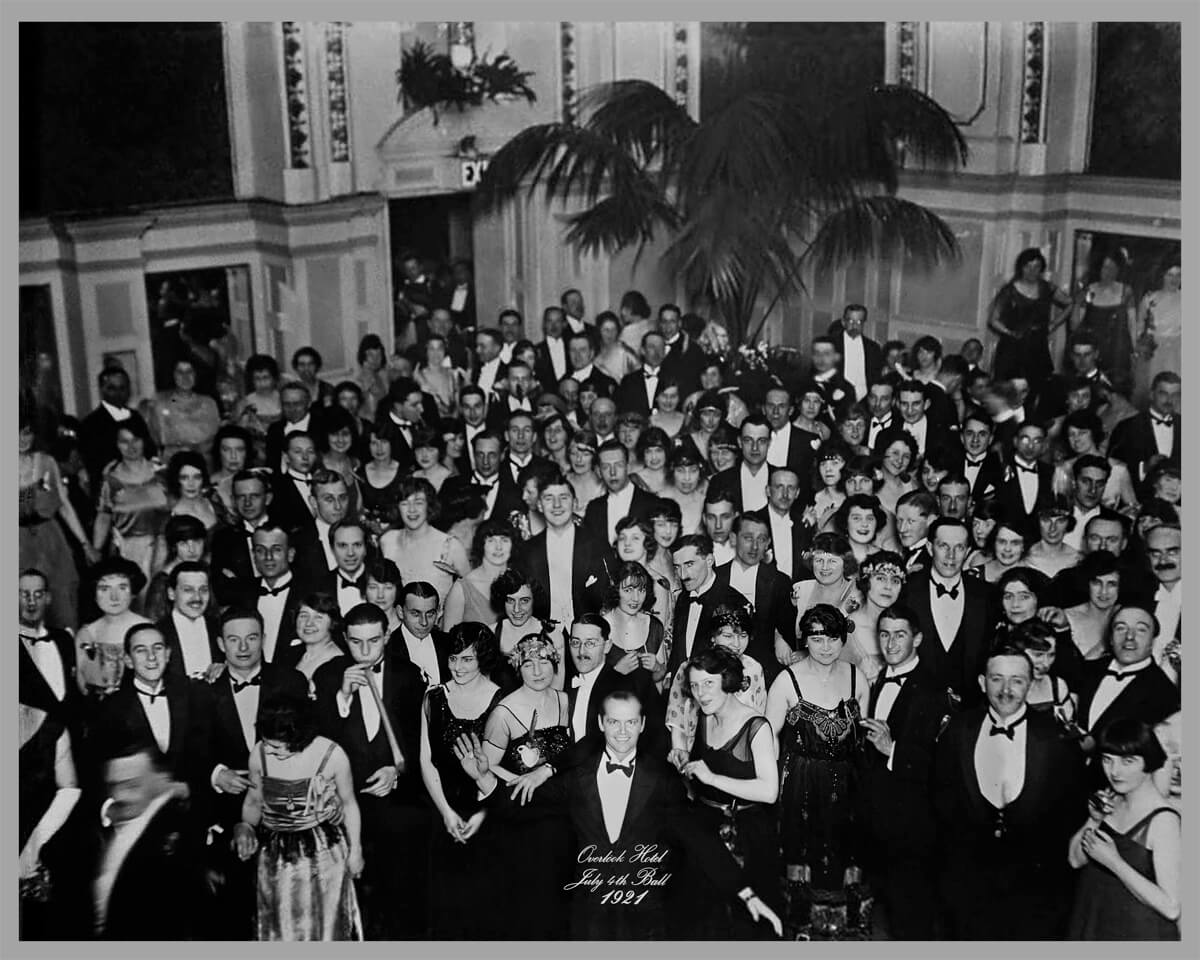
The bloodied gentleman who makes a toast at the end of the film saying “Great party, isn’t it?” was played by Norman Gay, a member of the film crew who edited The Shining.
The role of Danny was originally slated to be played by Cary Guffey, the little ice-cream chaser in Steven Spielberg’s 1977 Close Encounters of the Third Kind.
In one scene of the Buffy series Xander is playing with a ventriloquist doll and, pretending to be Danny’s voice, says “Redrum” (three times), giving the girls (Buffy and Willow) the shivers… The idea to quote Kubrick’s film, came from Nicholas Brendon (who plays the role of Xander in the series) and the line wasn’t scripted.
Stanley Kubrick shot The Shining chronologically, scene by scene, according to the script.
The Shining is ranked among the top 100 movies of all time in IMDb’s
The above text was written largely thanks to Mr. Maciej Parowski from “NOWA FANTASTYKA” and Mr. Wojciech Orlinski from “Gazeta Wyborcza” – who had an interesting discussion about the film before the screening of The Shining in Warsaw’s “Dorozkarnia”. The above text is therefore a collection of observations of the above-mentioned gentlemen, my thoughts and reflections on the film, and trivia related to The Shining, taken from IMDB. I do not claim the rights to call myself the author of the above text; rather, I am a person who has collected a lot of information from various sources and presented it in an accessible way, adding my own wisdom here and there so that the reader learns as much as possible about Kubrick’s film. Simply.




